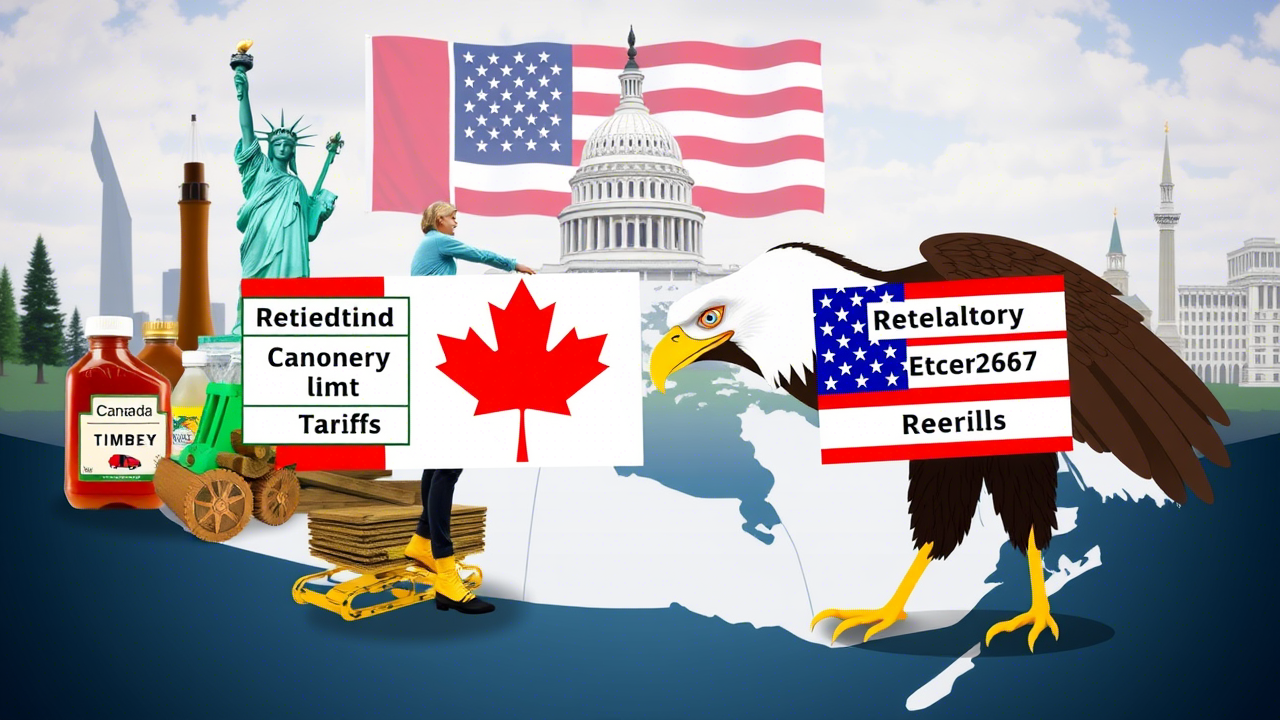Bedsure GentleSoft Sherpa Fleece Throw Blanket for Couch - Thick and Warm Christmas Blanket for Winter, Soft Fuzzy Plush Throw Gifts for Women and Men, Grey, 50x60 Inches
$18.99 (as of December 3, 2025 14:48 GMT +00:00 - More infoProduct prices and availability are accurate as of the date/time indicated and are subject to change. Any price and availability information displayed on [relevant Amazon Site(s), as applicable] at the time of purchase will apply to the purchase of this product.)The world of global trade is undergoing major changes. Countries are responding in big ways to new tariffs put in place by the United States. How will these back-and-forth tariffs impact normal people and their daily lives? Let’s take a closer look at the details.
Canada Imposes 25% Tariffs on $155 Billion of US Goods
Immediate Impact
In a bold move, Canada’s Prime Minister Justin Trudeau recently announced heavy new tariffs on US products. Right away, $30 billion worth of everyday goods will face an extra 25% tax at the Canadian border. This will likely make many American items in Canada more expensive very quickly.
Future Phases
But that’s not all. Over time, Canada plans to expand these tariffs to cover a whopping $155 billion in US goods. An additional $125 billion worth of products will be hit with the 25% tariff after a period of public comments. Nearly every corner of trade between the two countries will be affected.
Affected Products
So what kinds of products are we talking about? The list includes many things that regular Canadians buy and use each day. Grocery items like ketchup, orange juice, yogurt, and coffee are all included. Home goods like mattresses, fridges, and dishwashers will also be hit. Even items for outdoor fun, like boats, will face the extra taxes.
Economic Consequences
Experts think these tariffs could be a big deal for the economies of both countries. With so many products impacted, prices may go up noticeably for the average shopper. Some US companies could see sales to Canada drop. Since the two countries trade so much normally, the total economic damage could be significant if this drags on.
Mexico’s Response
Immediate Actions
Canada isn’t the only country fighting back against US tariffs. The US’s neighbor to the south, Mexico, is also jumping into the fray. Mexican President Claudia Sheinbaum recently announced that her country will also put 25% tariffs on many US goods coming into Mexico.
Economic Implications
Like Canada, Mexico trades a huge amount with the US every year. Taxing a big chunk of that could really shake up the economic relationship between the two countries. Many US industries, like farming, count on easy access to the Mexican market. This could spell trouble.
China’s Plan
WTO Lawsuit
On the other side of the world, China is making moves too. Chinese officials have said they intend to sue the US through the World Trade Organization (WTO). They argue that the recent US tariffs on China break international trade rules that most countries have agreed to follow.
Potential Tariffs
Along with the lawsuit, China is also hinting that it could put its own special tariffs on US products if this battle continues. Since the US and China are the world’s two biggest economies, a trade war between them could have very far-reaching effects. Businesses around the world are watching this situation closely.
Technical Insights and Economic Analysis
Tariff Mechanisms
So how do tariffs work? Essentially, they are taxes that a country puts on certain products coming in from other countries. By making foreign items more expensive, tariffs can push people to buy local products instead. Countries sometimes use them to shield their industries from outside competition.
Inflation and Consumer Prices
But tariffs can also have wider effects on the economy. One big concern is that they will drive up prices for consumers. If everyday products suddenly cost 25% more because of tariffs, people’s money won’t go as far. Experts are predicting this round of tariffs could cause a noticeable jump in inflation.
Industry-Specific Impacts
Certain industries could feel the pain of these tariffs more than others. Carmakers on both sides of the border are expecting a big hit. Farmers could struggle if they abruptly lose access to major markets. Energy companies are also watching carefully to see if important equipment gets more expensive.
Key Takeaways
To recap, here’s where things stand:
- Canada is placing 25% tariffs on $155 billion of US goods
- Mexico is imposing similar tariffs on US products
- China is suing the US and considering its tariffs
- Prices on many everyday items could rise in the affected countries
- Key industries like auto, agriculture, and energy could see serious disruption
- The total economic damage could be significant if the trade battle continues
The global trade landscape is rapidly shifting and the ultimate impacts are still unknown. But one thing is clear: the average consumer is likely to feel the effects of these tit-for-tat tariffs in their daily lives and budgets. Stay tuned as this story continues to unfold.
| Canada | Mexico | China | |
| Action | 25% tariffs on $155B of US goods | 25% tariffs on US goods | WTO lawsuit, potential tariffs |
| Key Impacts | Prices rise on many consumer products, hit to US industries | Disruption to critical US-Mexico trade relationship | Shockwaves through global economy, damage to US companies |
Data sources: Government announcements, economic analyst projections
What Do You Think?
How do you expect these tariffs to impact your life? Are you already seeing prices rise for certain products? What do you think the long-term effects on the global economy will be?
Share your thoughts and experiences in the comments below, and consider joining one of these communities for further discussion:
- r/Economics
- r/GlobalTrade
- r/Business
The more we can share information and perspectives, the better we can understand and adapt to these major changes in the world economy. Let’s continue the conversation!



